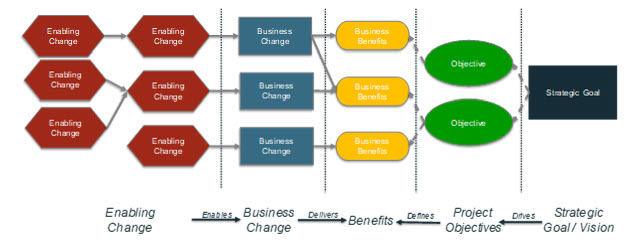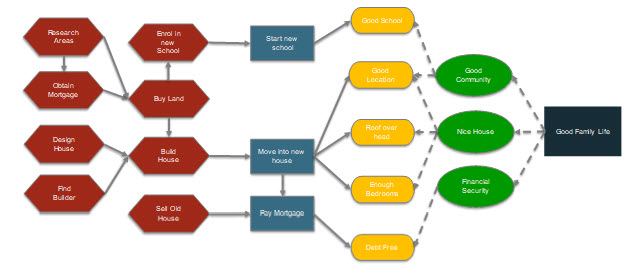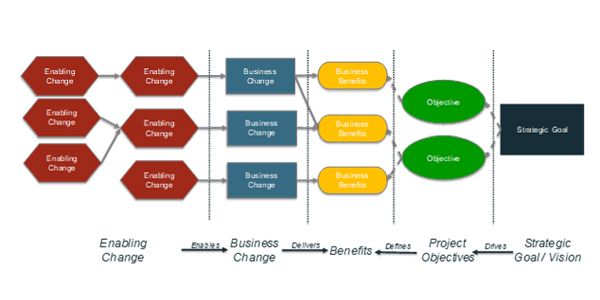The Benefits of Mapping Benefits
It is generally accepted that projects should deliver benefits – it’s a projects raison d’etre.
Yet projects often focus on the delivery of products, losing the link between project activities and business benefits. As a business analyst working in the public sector, I find this frustrating – projects should focus on the delivery of benefits.
Benefits mapping is useful analysis technique for understanding the links between project activities and benefits. Benefits maps provide a visual representation of the links between project activities and the delivery of benefits. As such, they can be used to foster a benefits-focused approach to project delivery.
What is a Benefits Map?
A benefits map (or benefits dependency network) is a useful technique for understanding how a project will deliver business benefits. According to the BCS, a benefits map is “A diagrammatic representation of what needs to be done on a project/program in order to achieve its expected benefit”. The idea is simple – link project activities to the benefits they directly impact.
There is no clear ‘standard’ for producing benefits maps. There are numerous variations, many of which are relevant to specific types of project of business initiative. However, the following elements generally apply to all projects and/or change initiatives:
- Enabling Changes – project deliverables/activities that support the delivery of a larger business change/deliverable
- Business Changes – the changes that project/initiative will implement
- Business Benefit – a measurable benefit that will be delivered as a result of a Business Change
- Objective – the project and/or business objectives supported by the project
- Strategic Goal / Business Driver (optional) – the overall goal, vision or threat that is driving the delivery of the project
Project deliverables and activities (or ‘Enabling Changes’) are mapped to Business Change deliverables, which in turn are mapped to the overall Benefits of the change. Benefit maps can then be extended to link Business Benefits to Project Objectives, which in turn should be linked to a Strategic Goal or Business Driver. As the example below shows, the result is a visual representation that clearly demonstrates the connection between project activities and an organisation’s strategic intent.

The relationship between changes, benefits and objectives is not always a one-to-one relationship. Below is a benefits map for a fictitious project to build and move a family into a new house. Although it sounds rather simplistic, further analysis of the changes, benefits and objectives shows the relationships between them are not clear cut.

Of course, this is my benefits map for my project to build a family home. My objectives and benefits may be different to someone else who is undertaking a similar project to build a house. Thus, while some of the project activities and changes may be the same, the benefits and objectives are likely to be different. The same logic applies to different organisations undertaking similar projects – you are unlikely to ever come across two benefits maps that are the same.
To get the most out of a benefits map, it should be produced early in a project/initiative, updated regularly, and reference throughout the project to keep the focus on benefits delivery.
Why Map Benefits
There are several reasons to map benefits. The most obvious is to assist in benefits planning and realisation – understanding what, how and when business changes are expected to deliver business benefits provides a basis for benefits planning and realisation activities. However, benefits maps can be used as a project management analysis technique to create a common understanding across several areas of a project.
Communication: Understand Why
Benefits maps are a useful technique for understanding and communicating the impact of a project from different stakeholder perspectives. Large projects/programs can consist of many moving parts, making it difficult for individual staff to see why certain activities or deliverables are considered important. It can also be difficult for business stakeholders to understand why they may need to change, and for managers to understand why certain activities are important. Benefits maps can support understanding across stakeholder perspective by allowing:
- project delivery staff to clearly see how the activities they undertake impact the delivery of benefits and, thus, contribute to the overall success of the project
- stakeholders to understand the benefits of change
- managers to understand the link between project activities and strategic objectives.
Risks: Assess Impact
Benefits maps can be used as a tool for quantifying project risks. By creating a clear link between project activities and benefits, benefit maps allow for risks associated with the delivery of project activities to be quantified in terms of the benefits they impact. Benefits maps are also useful in assessing the impact of a change to a projects budget, scope or timeline, supporting the assessment of any project change in terms of the benefits delivered.
Plans: Deliver Benefits
Benefits maps can be a useful tool for planning project activities. In much the same way as a Product Breakdown Structure is used to deconstruct project deliverables, benefits maps can be used to deconstruct what needs to be done in order to achieve a business benefit. The main difference between a Product Breakdown Structure and a benefits map is that the focus is on the business change and the benefits, rather than the deliverable.
As a business analyst involved in the project feasibility and initiation, I find benefits maps a much more powerful technique compared with product breakdown structures. Linking project activities to business benefits is a good way to justify project work and cost estimates. Benefits maps can also assist in constructing a business case narrative that describes how a project links with an organisations strategic objectives.
Conclusion
Benefit maps are a powerful analysis technique for supporting project management. Benefits can provide a common reference point when prioritising project activities, quantifying project risk, and communicating with stakeholders. To get maximum benefit from a benefit map, the benefits should be mapped early and referenced often to ensure a project stays focused on the delivery of benefits.
